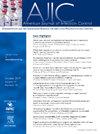Self-contamination risk and failure modes during high-level PPE doffing: A pilot comparison of 2 powered air-purifying respirator (PAPR) hoods
IF 3.8
3区 医学
Q2 INFECTIOUS DISEASES
引用次数: 0
Abstract
Background
Personal protective equipment doffing protocols can reduce risks of pathogen self-contamination. Powered air-purifying respirators may increase these risks. This study compares viral contamination and errors during simulated doffing of single-layer versus double-layer hood powered air-purifying respirators.
Methods
Eight participants performed 2 simulations (video recorded for failure modes [FMs] and effects analysis): 1 single-layer hood (laid over Tyvek suit) and 1 double-layer hood (top laid over and bottom tucked into suit). Hoods were contaminated with viruses. After doffing, inner gloves, face, hands, and scrubs were sampled.
Results
Virus contaminated at least 1 site in 6/8 single- and 5/8 double-layer simulations. Virus-contaminated inner gloves in single- (6 participants, median 5.42 × 104 plaque-forming units) and double-layer (2 participants, median 7.23 × 102 plaque-forming units) simulations, and hands of 2 participants in single-layer simulations. Single-layer doffing had 13 FMs; double had 31.
Discussion
Double-layer doffing reduced inner glove contamination. The double-layer protocol may reduce glove-face shield contact but allow more opportunities for error. Double-layer doffing errors may less frequently lead to contamination than single layer.
Conclusions
Contamination and FMs may differ between double- and single-layer doffing. Although inner glove contamination was reduced, double-layer doffing may need redesign to reduce FMs and contamination.
高水平个人防护装备降落过程中的自污染风险和失效模式:两种动力空气净化呼吸器(PAPR)罩的比较:一项试点研究。
背景:个人防护装备(PPE)脱布方案可以降低病原体自我污染的风险。电动空气净化呼吸器(papr)可能会增加这些风险。本研究比较了单层和双层遮光罩模拟落纱过程中的病毒污染和误差。方法:8名参与者进行了两次模拟(记录故障模式和影响分析的视频):一个单层兜帽(铺在Tyvek防护服上),一个双层兜帽(顶部铺在防护服上,底部塞进防护服)。头罩被病毒污染了。落纱后,对内手套、面部、手部和磨砂取样。结果:在6/8次单层模拟和5/8次双层模拟中,病毒至少污染了一个位点。单层模拟(6名参与者,中位数5.42×104 PFU)和双层模拟(2名参与者,中位数7.23×102 PFU)中病毒污染的内手套,以及单层模拟中2名参与者的手。单层落纱有13种破坏模式;Double有31个。讨论:双层落纱减少手套内污染。双层协议可能会减少手套和面罩的接触,但会增加出错的机会。双层落纱误差比单层落纱误差更少导致污染。结论:双层和单层落纱的污染和失效模式可能不同。虽然手套内部污染减少了,但双层落纱可能需要重新设计,以减少失效模式和污染。
本文章由计算机程序翻译,如有差异,请以英文原文为准。
求助全文
约1分钟内获得全文
求助全文
来源期刊
CiteScore
7.40
自引率
4.10%
发文量
479
审稿时长
24 days
期刊介绍:
AJIC covers key topics and issues in infection control and epidemiology. Infection control professionals, including physicians, nurses, and epidemiologists, rely on AJIC for peer-reviewed articles covering clinical topics as well as original research. As the official publication of the Association for Professionals in Infection Control and Epidemiology (APIC)

 求助内容:
求助内容: 应助结果提醒方式:
应助结果提醒方式:


